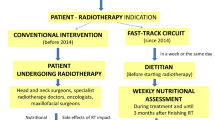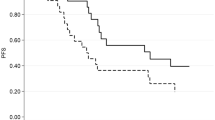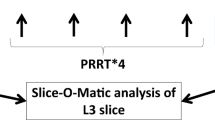Abstract
We assessed forty HNC patients receiving treatment with curative intent. Specific quantitative muscle and fat changes were evaluated using CT. Nutrition support was provided according to ESPEN guidelines, with adjusted body weight (ABW) in overweight/obese patients used to define their nutritional targets. Linear regression models were used to evaluate clinical predictors of tissue loss. Mean overall losses were body weight (−10.5%), and CT-defined muscle (−8.4%) and fat mass (−24.8%), p < 0.001. A subset of 20 patients had high muscle loss (−14.7%) with concurrent negative energy balance as reflected by considerable fat loss (−29.7%); those tended to have higher baseline body mass index (26.2 vs. 23.3 kg/m2, p = 0.063). In multivariate regression, only ABW independently predicted muscle loss (p < 0.001) and fat loss (p = 0.002). Nutrition support according to guidelines was appropriate for a subset of patients. ABW use to set nutrition targets in overweight/obese patients would appear to be insufficient, based on large tissue losses.
This is a preview of subscription content, access via your institution
Access options
Subscribe to this journal
Receive 12 print issues and online access
$259.00 per year
only $21.58 per issue
Buy this article
- Purchase on Springer Link
- Instant access to full article PDF
Prices may be subject to local taxes which are calculated during checkout
Similar content being viewed by others
References
Shachar SS, Williams GR, Muss HB, Nishijima TF. Prognostic value of sarcopenia in adults with solid tumours: a meta-analysis and systematic review. Eur J Cancer. 2016;57:58–67.
Kazemi-Bajestani SMR, Becher H, Butts C, Basappa NS, Smylie M, Joy AA, et al. Rapid atrophy of cardiac left ventricular mass in patients with non-small cell carcinoma of the lung. J Cachexia Sarcopenia Muscle. 2019. https://doi.org/10.1002/jcsm.12451.
Krenitsky J. Adjusted body weight, pro: evidence to support the use of adjusted body weight in calculating calorie requirements. Nutr Clin Pr. 2005;20:468–73.
Tao W, Lagergren J. Clinical management of obese patients with cancer. Nat Rev Clin Oncol. 2013;10:519–33.
ICO-ICS Praxi para el tratamiento médico y con irradiación del cáncer de orofaringe, hipofaringe, laringe y nasolaringe. http://ico.gencat.cat/web/.content/minisite/ico/professionals/documents/arxius/ICO-ICS_cabezaycuello_2017_DEFINITIVA.pdf.
U.S Department of Health and Human Services. Common terminology criteria for adverse events (CTCAE). 2017. https://ctep.cancer.gov/protocoldevelopment/electronic_applications/docs/CTCAE_v5_Quick_Reference_8.5x11.pdf.
Therasse P, Arbuck SG, Eisenhauer EA, Wanders J, Kaplan RS, Rubinstein L, et al. New guidelines to evaluate the response to treatment in solid tumors. European Organization for Research and Treatment of Cancer, National Cancer Institute of the United States, National Cancer Institute of Canada. J Natl Cancer Inst. 2000;92:205–16.
Shen W, Punyanitya M, Wang Z, Gallagher D, St-Onge M-P, Albu J, et al. Total body skeletal muscle and adipose tissue volumes: estimation from a single abdominal cross-sectional image. J Appl Physiol. 2004;97:2333–8.
Prado CMM, Lieffers JR, McCargar LJ, Reiman T, Sawyer MB, Martin L, et al. Prevalence and clinical implications of sarcopenic obesity in patients with solid tumours of the respiratory and gastrointestinal tracts: a population-based study. Lancet Oncol. 2008;9:629–35.
Ireton-Jones C. Adjusted body weight, con: why adjust body weight in energy-expenditure calculations? Nutr Clin Pr. 2005;20:474–9.
Acknowledgements
We thank Maria Sospedra and Regina González-Tampán from the clinical nutrition unit for their scientific and technical assistance. We acknowledge the Head and Neck Cancer Unit (Bellvitge University Hospital-Catalan Institute of Oncology (HUB-ICO)) for patient recruitment and for taking dietitians as part of the multidisciplinary team.
Author information
Authors and Affiliations
Corresponding author
Ethics declarations
Conflict of interest
The authors declare that they have no conflict of interest.
Additional information
Publisher’s note Springer Nature remains neutral with regard to jurisdictional claims in published maps and institutional affiliations.
Rights and permissions
About this article
Cite this article
Arribas, L., Sabaté-Llobera, A., Taberna, M. et al. Adequacy of nutritional support using computed tomography (CT) in patients with head and neck cancer (HNC) during chemo-radiotherapy (CRT). Eur J Clin Nutr 75, 1515–1519 (2021). https://doi.org/10.1038/s41430-021-00863-z
Received:
Revised:
Accepted:
Published:
Issue Date:
DOI: https://doi.org/10.1038/s41430-021-00863-z



